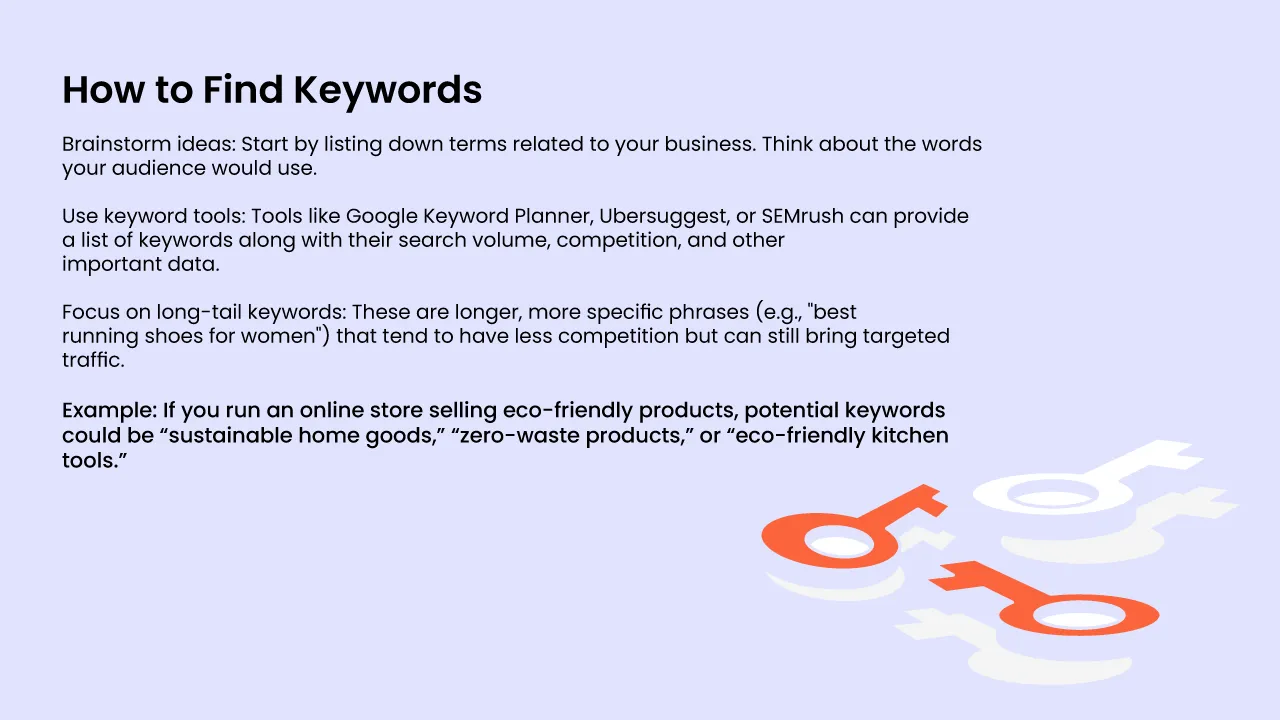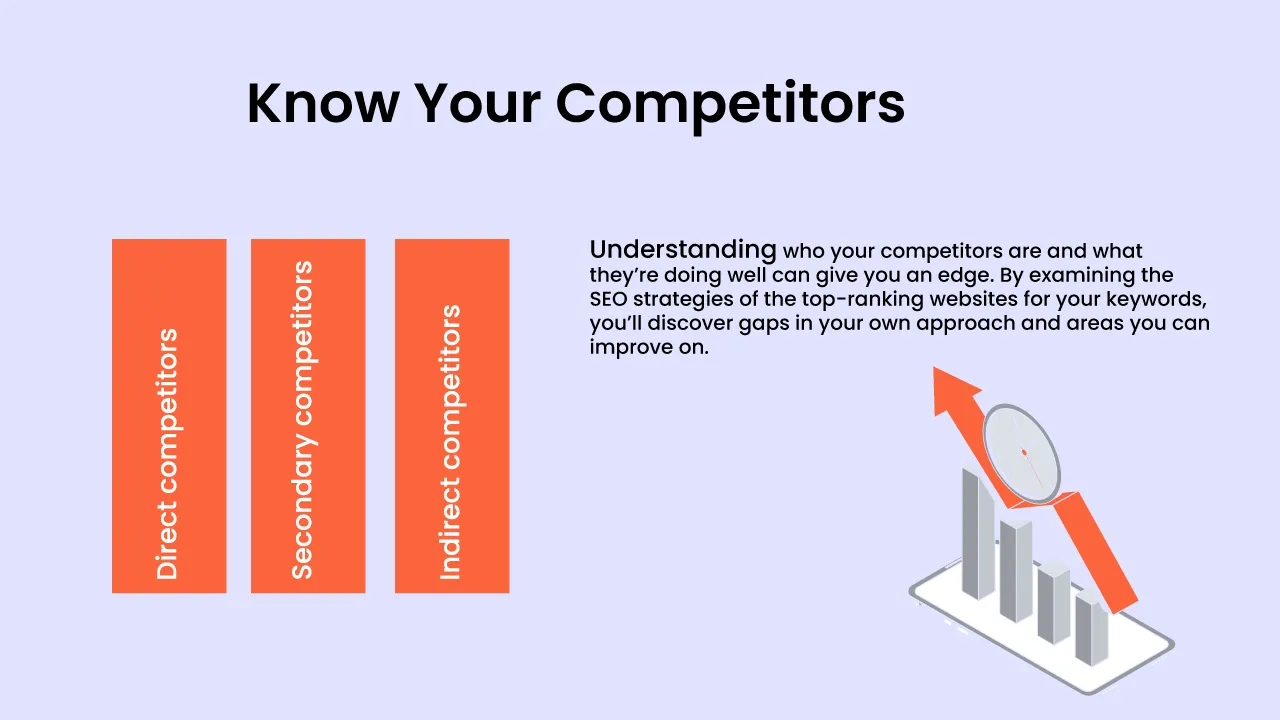SEO (Search Engine Optimization) can seem like a complex puzzle at first, but with the right strategy, it becomes much easier to grasp and execute. A well-crafted SEO strategy can bring in organic traffic, improve your site’s visibility, and help you outperform competitors. We’ll break down the essential steps to build an effective SEO strategy that’s easy to understand and implement, through this article.
What Is an SEO Strategy?

An SEO strategy is an in-detail plan aimed at improving a website’s rankings on search engines like Google. The goal is to attract more visitors by optimizing your content and website to match the criteria search engines use to rank pages. This plan covers everything from choosing the right keywords to building backlinks and optimizing your content for user intent.
Now, let’s go through each step of creating an effective SEO strategy.
Make a List of Keywords

Keywords are the foundation of any SEO strategy. They’re the words and phrases people type into search engines when looking for information, products, or services. To start your effective SEO plan, you’ll want to identify a set of keywords that are relevant to your niche and that potential customers are likely searching for.
How to Find Keywords
- Brainstorm ideas: Start by listing down terms related to your business. Think about the words your audience would use.
- Use keyword tools: Tools like Google Keyword Planner, Ubersuggest, or SEMrush can provide a list of keywords along with their search volume, competition, and other important data.
- Focus on long-tail keywords: These are longer, more specific phrases (e.g., “best running shoes for women”) that tend to have less competition but can still bring targeted traffic.
Example: If you run an online store selling eco-friendly products, potential keywords could be “sustainable home goods,” “zero-waste products,” or “eco-friendly kitchen tools.”
Have a look at Google’s First Page

Once you have your keywords, the next step is to analyze the top-ranking pages on Google for those terms. This helps you understand what’s working and why these pages are ranking at the top.
What to Look For
- Content length: Are the top-ranking articles long and detailed or short and concise?
- Format: Is the content presented as a blog post, a list, a video, or something else?
- Headings and subheadings: See how they structure their content. What kind of information do they prioritize?
Example: If you’re trying to rank for “best fitness trackers,” look at the top pages to see if they are product reviews, comparison guides, or listicles.
Know Your Competitors

Understanding who your competitors are and what they’re doing well can give you an edge. By examining the SEO strategies of the top-ranking websites for your keywords, you’ll discover gaps in your own approach and areas you can improve on.
How to Analyze Competitors
- Backlinks: Use tools like Ahrefs or Moz to see where your competitors are getting their backlinks from. Backlinks are links from other websites that point to your page and signal authority to search engines.
- Content type: Identify the type of content they’re creating. Are they focused on blog posts, videos, or infographics?
- Social signals: Check how often their content is shared on social media. While not a direct ranking factor, it can still indicate content popularity.
Example: If you’re competing in the personal finance niche, study what’s working for the leading blogs. Do they offer downloadable guides or calculators? Are they publishing case studies?
Do Something Different or Better
Now that you know what your competitors are doing, it’s time to create content that stands out. Your content should either be different or better than what’s already out there. This doesn’t mean reinventing the wheel, but adding unique value that other pages may lack.
Ways to Create Better Content
- Go deeper: If the top-ranking articles skim the surface, dive deeper into the topic by providing more detailed insights, examples, or data.
- Offer something unique: This could be a new perspective, original research, or even a user-friendly infographic.
- Make it more engaging: Improve the readability and presentation of your content by adding visuals, subheadings, and clear bullet points.
Example: If most articles about “healthy smoothie recipes” list the same ingredients, you could create a detailed guide with nutritional breakdowns, tips for customization, and expert advice on balancing flavors.
Add a Hook

The hook is what grabs attention and keeps readers engaged. In the context of SEO, a hook can also be something that attracts backlinks, shares, and high dwell time (how long visitors stay on your page).
Types of Hooks
- Statistics: People love data. Including relevant statistics can make your content more authoritative and link-worthy.
- Infographics or videos: Visual content is easier to digest and share.
- Personal stories: Adding a personal touch to your content can help it resonate with readers and stand out in a sea of generic content.
Example: If you’re writing about fitness tips, share your own success story or client testimonials to make the content more relatable.
Optimize On-Page SEO

On-page SEO involves optimizing various elements on your webpage to improve its visibility in search results. This is where you focus on things like titles, meta descriptions, headings, and internal links.
Key On-Page SEO Factors
- Title tags and meta descriptions: These are the first things users see on the search results page, so make them compelling and keyword-rich.
- Headings (H1, H2, H3): Use headings to break up your content and include keywords naturally.
- Internal linking: Link to other relevant pages on your site to help search engines understand your site’s structure and keep readers engaged.
Example: Let’s say you’re optimizing a blog post about “beginner’s yoga tips.” Make sure your H1 is clear (e.g., “Yoga Tips for Beginners”) and your meta description includes keywords and a hook (e.g., “Discover easy yoga tips to help you get started and stay motivated”).
Optimize For Search Intent
Search intent refers to the reason behind a user’s search. Are they looking for information, trying to buy something, or just comparing options? Optimizing for search intent means ensuring your content aligns with what the user expects to find when they type in a particular keyword.
Types of Search Intent
- Informational: The user is looking for answers to a question (e.g., “how to make sourdough bread”).
- Transactional: The user is looking to make a purchase (e.g., “buy organic coffee beans”).
- Navigational: The user is searching for a specific website (e.g., “Facebook login”).
Example: If someone searches for “best budget laptops 2024,” they’re likely looking for product comparisons or buying guides, not an article on the history of laptops. Make sure your content fits their needs.
Unique Content Design

A well-designed page isn’t just visually appealing—it’s also optimized for SEO. Search engines favor sites that are easy to navigate and offer a great user experience.
Content Design Tips
- Mobile-friendliness: Ensure your site looks good and loads fast on mobile devices, as Google prioritizes mobile-first indexing.
- Readability: Organize your text with subheadings, bullet points, and short paragraphs. Use a readable font size.
- Multimedia: Include images, videos, or infographics to make your content more engaging.
Example: A guide on “how to train for a marathon” could include easy-to-scan training schedules, embedded videos of stretching exercises, and downloadable workout plans.
Build Links to Your Page
Backlinks (links from other sites to your page) are one of the most important ranking factors for SEO. If you link reputable sites to your content, it signals to search engines that your page is valuable and authoritative.
How to Build Backlinks
- Guest blogging: Write guest posts for reputable sites in your industry, and link back to your own content.
- Outreach: Reach out to bloggers or journalists who might find your content useful and request a link.
- Create linkable content: Content like infographics, original research, and in-depth guides are more likely to attract backlinks.
Example: If you publish a unique study on consumer behavior, reach out to other blogs or media outlets that cover industry news and ask them to reference your findings.
Keep Updating Your Content

SEO is an ongoing process. Search engines love fresh, relevant content, so it’s important to revisit your pages regularly and make updates as needed.
How to Keep Content Fresh
- Update stats and information: Ensure your data is up to date and relevant.
- Add new sections: If new trends or developments have emerged, update your content to include them.
- Refresh keywords: Use tools to see if new keywords have emerged and optimize your content accordingly.
Example: If you have an article about “social media marketing trends for 2023,” update it to reflect trends for 2024 and beyond.
Conclusion
Building an effective SEO strategy doesn’t have to be overwhelming. By following the steps outlined in this article, you’ll be well on your way to improving your search rankings, driving traffic to your site, and ultimately achieving your online goals. Remember, SEO is a long-term game, so consistency is very important here, monitor your progress, and always look for ways to improve.
FAQs About SEO Strategy
1. How often should I update my SEO strategy?
You should review your site every 3-6 months, depending on changes in search algorithms and industry trends.
2. What is the difference between SEO and SEM?
SEO focuses on organic search results, while SEM (Search Engine Marketing) includes paid advertising to increase visibility on search engines.
3. How long does it take to see results from SEO?
Results can vary, but it usually takes 3-6 months to show results.
4. Can I do SEO myself, or should I hire an expert?
You can absolutely start learning and implementing SEO yourself, but hiring an expert can speed up the process and bring more specialized knowledge.
5. What are some free tools to help with SEO?
Some popular free tools include Google Analytics, Google Search Console, and Ubersuggest.
